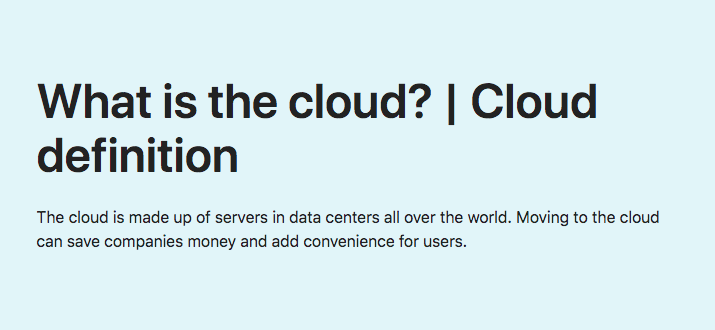Cloud Definition: Servers in data centres all around the world make up the cloud. Moving to the cloud may save businesses money while also providing users with more convenience.

Learning Objectives
After reading this article you will be able to:
- Know the Cloud Definition
- Learn what ‘the cloud’ means
- Understand how the cloud works
- Explore the different cloud models and possible cloud deployments
What is the Cloud?
Explanation of Cloud Definition. The term “cloud” refers to Internet-accessible servers, as well as the software and databases that operate on those servers. Cloud servers are housed in many data centres across the world. Users and businesses don’t have to operate physical servers or run software programmes on their own devices when they employ cloud computing.
Because processing and storage takes place on servers in a data centre rather than locally on the user device, cloud users may access the same files and apps from practically any device. This is why, if a user’s old phone breaks, they can go into their Instagram account on a new phone and discover their previous account intact, complete with all of their images, videos, and chat history. It’s the same with cloud email services like Gmail and Microsoft Office 365, as well as cloud storage services like Dropbox and Google Drive.
Switching to cloud computing reduces some IT expenses and overhead for businesses: for example, they no longer need to upgrade and maintain their own servers because the cloud vendor will do so. This has a significant influence on small firms that may not be able to finance their own internal infrastructure but may outsource their infrastructure needs to the cloud at a reasonable cost. Because employees and consumers can access the same data and apps from any place, the cloud can make it easier for businesses to function worldwide.
How does Cloud Computing work?
Virtualization is a technique that makes cloud computing feasible. Virtualization allows you to create a simulated, digital-only “virtual” computer that acts like a real computer with its own hardware. A virtual machine is the technical word for such a computer. Virtual machines on the same host computer are sandboxed from one another when correctly designed, so they don’t communicate at all, and the files and programmes from one virtual machine aren’t accessible to the other virtual machines, despite the fact that they’re on the same physical machine.
Virtual machines also make better use of the hardware on which they run. One server becomes many servers, and a data centre becomes a whole host of data centres capable of serving numerous companies, by operating multiple virtual machines at the same time. As a result, cloud providers may provide access to their servers to much more clients at once than they could otherwise, and at a lower cost.
Even if individual servers fail, cloud servers as a whole should remain online and accessible at all times. Cloud providers often back up their services across several computers and locations.
Users access cloud services via a browser or an app, connecting to the cloud via the Internet – that is, a network of interconnected networks – regardless of the device they’re using.
What are the main service models of Cloud Computing?
Software-as-a-Service (SaaS):
Instead of installing an app on a user’s device, SaaS apps are hosted on cloud servers and accessed over the Internet. SaaS is similar to renting a home: the landlord takes care of the property, while the renter gets to utilise it as if it were their own. Salesforce, MailChimp, and Slack are examples of SaaS apps. See more details.
Platform-as-a-Service (PaaS):
In this approach, businesses do not pay for hosted apps; instead, they pay for the resources they need to create their own. PaaS suppliers provide everything needed to construct an application via the Internet, including development tools, infrastructure, and operating systems. PaaS is comparable to renting all of the tools and equipment needed to build a house rather than the house itself. Heroku and Microsoft Azure are two instances of PaaS. See more details.
Infrastructure-as-a-Service (IaaS):
In this approach, a firm rents from a cloud provider the servers and storage it requires. They then develop their apps on top of that cloud architecture. IaaS is similar to a corporation renting a piece of land on which they may construct whatever they want – but they must furnish their own construction equipment and supplies. DigitalOcean, Google Compute Engine, and OpenStack are examples of IaaS providers.
Previously, the three major paradigms of cloud computing were SaaS, PaaS, and IaaS, and almost all cloud services fell into one of these categories. In recent years, however, a fourth paradigm has emerged: See more details.
Function-as-a-Service (FaaS)
This is also known as serverless computing, breaks down cloud applications into smaller components that operate only when they’re needed. Imagine being able to rent a house in little chunks: for example, the renter only pays for the dining room while they’re eating, the bedroom when they’re sleeping, and the living room when they’re watching TV, and they don’t have to pay rent on those rooms when they’re not using them.
All of these cloud computing paradigms, including FaaS or serverless apps, nevertheless operate on servers. However, they’re referred to as “serverless” since they don’t operate on dedicated computers and the firms who create them don’t have to manage any servers.
Additionally, when more people use the app, serverless services scale up, or duplicate — think if the tenant’s dining room could grow on demand as more people came over for dinner! To learn more about serverless computing, click here (FaaS).
RELATED CONTENT
- What Is the Cloud?
- What Is Hybrid Cloud?
- What is Cloud Migration?
- What Is a Cloud Firewall?
- What Is Multicloud?
- What is Software-as-a-Service (SaaS)?